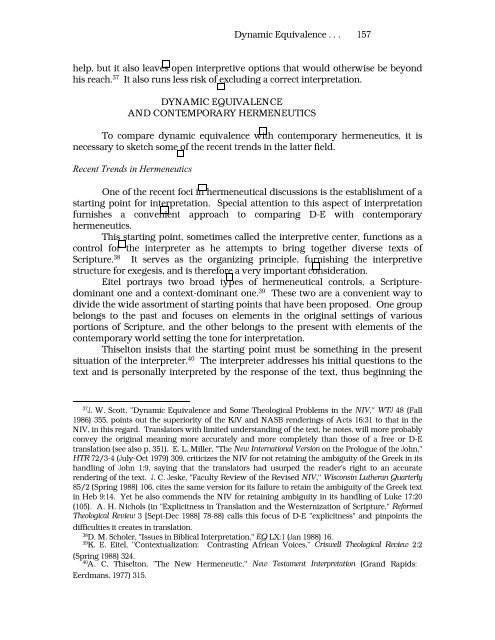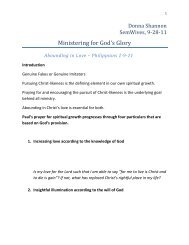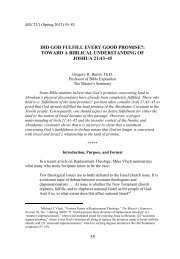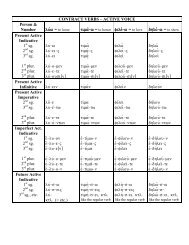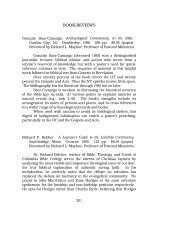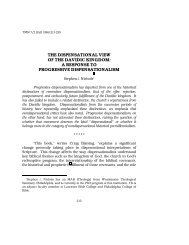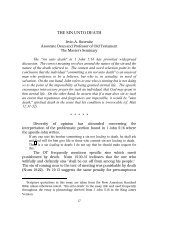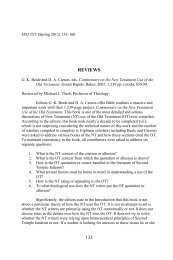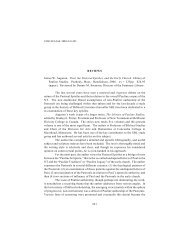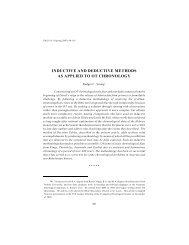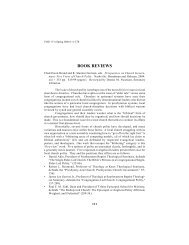156 The Master's Seminary Journalprevent <strong>or</strong> hinder, to serve as an obstacle." 31 He should have indicated that thiswas only a personal opinion because his statement is blatantly inaccurateacc<strong>or</strong>ding to auth<strong>or</strong>ities on the English language. Webster's unabridged dictionarygives the following as the first definition <strong>of</strong> the expression "in the way <strong>of</strong>": "so as tomeet <strong>or</strong> fall in with; in a fav<strong>or</strong>able position f<strong>or</strong> doing <strong>or</strong> getting." 32 This is clearlythe c<strong>or</strong>rect idea conveyed by the Hebrew, that <strong>of</strong> "associate with." The blessedman does not place himself in a compromising position with sinners.Unf<strong>or</strong>tunately the reaction <strong>of</strong> Glassman and others against a f<strong>or</strong>mal<strong>equivalence</strong>rendering <strong>of</strong> Psalm 1:1 is characteristic <strong>of</strong> other ill-advised conclusionsby D-E advocates. This is surprising, f<strong>or</strong> some <strong>of</strong> these are leading linguists who asa part <strong>of</strong> their <strong>method</strong>ology advocate a careful respect f<strong>or</strong> the referential meanings<strong>of</strong> w<strong>or</strong>ds and expressions as they appear in dictionary resources. 33 Yet theydisregard their own advice. F<strong>or</strong> example, de Waard and Nida object to f<strong>or</strong>mal<strong>equivalence</strong>renderings <strong>of</strong> Psalm 23:1, "The L<strong>or</strong>d is my shepherd, I shall not want,"by stating flatly, "want no longer means `to lack' but rather `to desire.'" 34 Incontrast, contemp<strong>or</strong>ary dictionaries give the intransitive verb "want" a firstmeaning <strong>of</strong> "lack" <strong>or</strong> "have a need," 35 exactly what the psalmist intended to say. 36Rather than c<strong>or</strong>recting the f<strong>or</strong>mal-<strong>equivalence</strong> translat<strong>or</strong>s, the linguistic specialistsshould have acknowledged the legitimacy <strong>of</strong> their w<strong>or</strong>d choice. They would alsohave been m<strong>or</strong>e credible if they had prefaced their critical remark with "in oursphere <strong>of</strong> knowledge" <strong>or</strong> "acc<strong>or</strong>ding to our judgment," but to say withoutqualification "want no longer means `to lack'" raises questions about their judgmentin general.F<strong>or</strong>mal-<strong>equivalence</strong> <strong>translation</strong>s handle ambiguities in exactly the oppositeway. In the recept<strong>or</strong> rendering they maintain as far as possi-ble the sameambiguity that exists in the source language. This places a heavier responsibilityupon the reader and student <strong>of</strong> the English text by f<strong>or</strong>cing him either to interpretthe passage himself <strong>or</strong> to res<strong>or</strong>t to a commentary <strong>or</strong> Bible teacher <strong>or</strong> exposit<strong>or</strong> f<strong>or</strong>31Glassman, Translation Debate 108. Carson, "The Limits" 5, and de Waard and Nida, From OneLanguage 33, use the same illustration. Glassman is cited because his w<strong>or</strong>k has the earliestpublication date, though he had access to the unpublished manuscript <strong>of</strong> de Waard and Nida(Glassman, Translation Debate 127 [ch 6, n 7]) and may have obtained it from them.32Webster's New Twentieth Century 2071. This same source gives as the first definition <strong>of</strong> "in theway" the idea <strong>of</strong> obstructing, impeding, <strong>or</strong> hindering, but "in the way <strong>of</strong>" is a separate entry (ibid.).Webster's New Collegiate Dictionary, on the other hand, defines "in the way" as meaning, first <strong>of</strong> all, "ina position to be encountered by one: in <strong>or</strong> along one's course" (1325). The idea <strong>of</strong> hindrance <strong>or</strong>obstruction is not introduced until the second definition in this latter source. Similarly, Webster'sThird New International Dictionary defines "in the way" as follows: "on <strong>or</strong> along one's path, road, <strong>or</strong>course: in a position to be encountered by one" (2588).33Nida, Toward a Science 70.34de Waard and Nida, From One Language 9.35Webster's New Twentieth Century 2059. Webster's New Collegiate gives "to be needy <strong>or</strong> destitute"as the first meaning and "to have <strong>or</strong> feel need" as the second (1327). The definition inc<strong>or</strong>p<strong>or</strong>ating theidea <strong>of</strong> "desire" is not given until the fourth definition. After giving an obsolete definition, Webster'sThird New International Dictionary defines "want" by "to be in need" in the first non-obsolete meaning.36Another f<strong>or</strong>mal <strong>equivalence</strong> rendering such as "lack" may be clearer in the minds <strong>of</strong> some than"want," but "want" is still a very legitimate option.
Dynamic Equivalence . . . 157help, but it also leaves open interpretive options that would otherwise be beyondhis reach. 37 It also runs less risk <strong>of</strong> excluding a c<strong>or</strong>rect interpretation.DYNAMIC EQUIVALENCEAND CONTEMPORARY HERMENEUTICSTo compare <strong>dynamic</strong> <strong>equivalence</strong> with contemp<strong>or</strong>ary hermeneutics, it isnecessary to sketch some <strong>of</strong> the recent trends in the latter field.Recent Trends in HermeneuticsOne <strong>of</strong> the recent foci in hermeneutical discussions is the establishment <strong>of</strong> astarting point f<strong>or</strong> interpretation. Special attention to this aspect <strong>of</strong> interpretationfurnishes a convenient approach to comparing D-E with contemp<strong>or</strong>aryhermeneutics.This starting point, sometimes called the interpretive center, functions as acontrol f<strong>or</strong> the interpreter as he attempts to bring together diverse texts <strong>of</strong>Scripture. 38 It serves as the <strong>or</strong>ganizing principle, furnishing the interpretivestructure f<strong>or</strong> exegesis, and is theref<strong>or</strong>e a very imp<strong>or</strong>tant consideration.Eitel p<strong>or</strong>trays two broad types <strong>of</strong> hermeneutical controls, a Scripturedominantone and a context-dominant one. 39 These two are a convenient way todivide the wide ass<strong>or</strong>tment <strong>of</strong> starting points that have been proposed. One groupbelongs to the past and focuses on elements in the <strong>or</strong>iginal settings <strong>of</strong> variousp<strong>or</strong>tions <strong>of</strong> Scripture, and the other belongs to the present with elements <strong>of</strong> thecontemp<strong>or</strong>ary w<strong>or</strong>ld setting the tone f<strong>or</strong> interpretation.Thiselton insists that the starting point must be something in the presentsituation <strong>of</strong> the interpreter. 40 The interpreter addresses his initial questions to thetext and is personally interpreted by the response <strong>of</strong> the text, thus beginning the37J. W. Scott, "Dynamic Equivalence and Some Theological Problems in the NIV," WTJ 48 (Fall1986) 355, points out the superi<strong>or</strong>ity <strong>of</strong> the KJV and NASB renderings <strong>of</strong> Acts 16:31 to that in theNIV, in this regard. Translat<strong>or</strong>s with limited understanding <strong>of</strong> the text, he notes, will m<strong>or</strong>e probablyconvey the <strong>or</strong>iginal meaning m<strong>or</strong>e accurately and m<strong>or</strong>e completely than those <strong>of</strong> a free <strong>or</strong> D-E<strong>translation</strong> (see also p. 351). E. L. Miller, "The New International Version on the Prologue <strong>of</strong> the John,"HTR 72/3-4 (July-Oct 1979) 309, criticizes the NIV f<strong>or</strong> not retaining the ambiguity <strong>of</strong> the Greek in itshandling <strong>of</strong> John 1:9, saying that the translat<strong>or</strong>s had usurped the reader's right to an accuraterendering <strong>of</strong> the text. J. C. Jeske, "Faculty Review <strong>of</strong> the Revised NIV," Wisconsin Lutheran Quarterly85/2 (Spring 1988) 106, cites the same version f<strong>or</strong> its failure to retain the ambiguity <strong>of</strong> the Greek textin Heb 9:14. Yet he also commends the NIV f<strong>or</strong> retaining ambiguity in its handling <strong>of</strong> Luke 17:20(105). A. H. Nichols (in "Explicitness in Translation and the Westernization <strong>of</strong> Scripture," Ref<strong>or</strong>medTheological Review 3 [Sept-Dec 1988] 78-88) calls this focus <strong>of</strong> D-E "explicitness" and pinpoints thedifficulties it creates in <strong>translation</strong>.38D. M. Scholer, "Issues in Biblical Interpretation," EQ LX:1 (Jan 1988) 16.39K. E. Eitel, "Contextualization: Contrasting African Voices," Criswell Theological Review 2:2(Spring 1988) 324.40A. C. Thiselton, "The New Hermeneutic," New Testament Interpretation (Grand Rapids:Eerdmans, 1977) 315.


